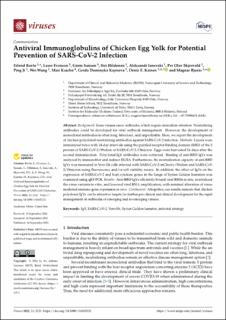Antiviral Immunoglobulins of Chicken Egg Yolk for Potential Prevention of SARS-CoV-2 Infection
| dc.contributor.author | Ravlo, Erlend | |
| dc.contributor.author | Evensen, Lasse | |
| dc.contributor.author | Sanson, Gorm | |
| dc.contributor.author | Hildonen, Siri | |
| dc.contributor.author | Ianevski, Aleksandr | |
| dc.contributor.author | Skjervold, Per Olav | |
| dc.contributor.author | Ji, Ping | |
| dc.contributor.author | Wang, Wei | |
| dc.contributor.author | Kaarbø, Mari | |
| dc.contributor.author | Kaynova, Gerda Dominyka | |
| dc.contributor.author | Kainov, Denis | |
| dc.contributor.author | Bjørås, Magnar | |
| dc.date.accessioned | 2023-01-20T09:05:36Z | |
| dc.date.available | 2023-01-20T09:05:36Z | |
| dc.date.created | 2022-12-02T13:53:08Z | |
| dc.date.issued | 2022 | |
| dc.identifier.issn | 1999-4915 | |
| dc.identifier.uri | https://hdl.handle.net/11250/3044847 | |
| dc.description.abstract | Background: Some viruses cause outbreaks, which require immediate attention. Neutralizing antibodies could be developed for viral outbreak management. However, the development of monoclonal antibodies is often long, laborious, and unprofitable. Here, we report the development of chicken polyclonal neutralizing antibodies against SARS-CoV-2 infection. Methods: Layers were immunized twice with 14-day intervals using the purified receptor-binding domain (RBD) of the S protein of SARS-CoV-2/Wuhan or SARS-CoV-2/Omicron. Eggs were harvested 14 days after the second immunization. Polyclonal IgY antibodies were extracted. Binding of anti-RBD IgYs was analyzed by immunoblot and indirect ELISA. Furthermore, the neutralization capacity of anti-RBD IgYs was measured in Vero-E6 cells infected with SARS-CoV-2-mCherry/Wuhan and SARS-CoV-2/Omicron using fluorescence and/or cell viability assays. In addition, the effect of IgYs on the expression of SARS-CoV-2 and host cytokine genes in the lungs of Syrian Golden hamsters was examined using qRT-PCR. Results: Anti-RBD IgYs efficiently bound viral RBDs in situ, neutralized the virus variants in vitro, and lowered viral RNA amplification, with minimal alteration of virus-mediated immune gene expression in vivo. Conclusions: Altogether, our results indicate that chicken polyclonal IgYs can be attractive targets for further pre-clinical and clinical development for the rapid management of outbreaks of emerging and re-emerging viruses. | en_US |
| dc.language.iso | eng | en_US |
| dc.publisher | MDPI | en_US |
| dc.rights | Navngivelse 4.0 Internasjonal | * |
| dc.rights.uri | http://creativecommons.org/licenses/by/4.0/deed.no | * |
| dc.title | Antiviral Immunoglobulins of Chicken Egg Yolk for Potential Prevention of SARS-CoV-2 Infection | en_US |
| dc.title.alternative | Antiviral Immunoglobulins of Chicken Egg Yolk for Potential Prevention of SARS-CoV-2 Infection | en_US |
| dc.type | Peer reviewed | en_US |
| dc.type | Journal article | en_US |
| dc.description.version | publishedVersion | en_US |
| dc.source.volume | 14 | en_US |
| dc.source.journal | Viruses | en_US |
| dc.source.issue | 10 | en_US |
| dc.identifier.doi | 10.3390/v14102121 | |
| dc.identifier.cristin | 2087805 | |
| dc.relation.project | European Regional Development Fund: MOBTT39 | en_US |
| cristin.ispublished | true | |
| cristin.fulltext | original | |
| cristin.qualitycode | 1 |

